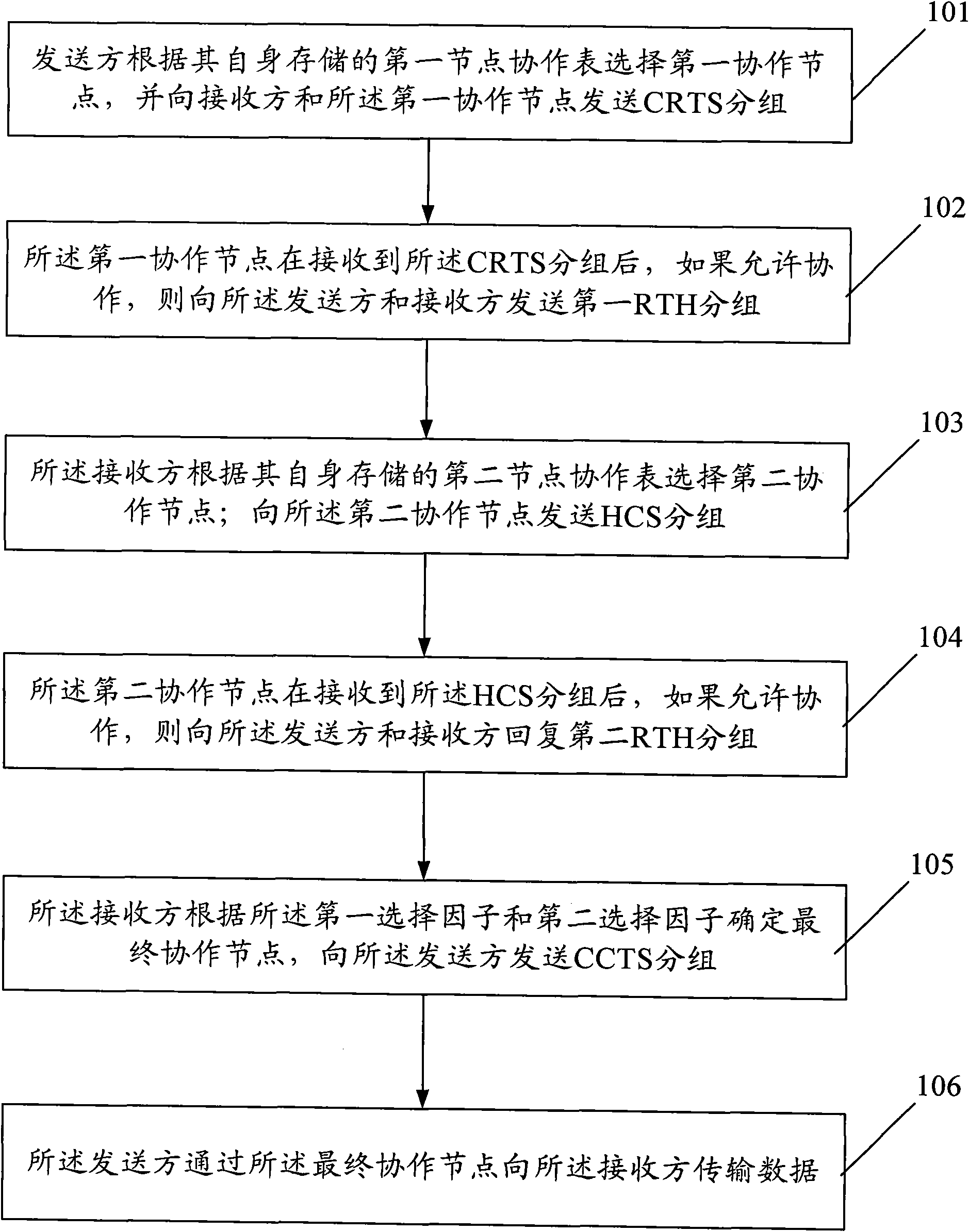Multi-relay selection cooperative transmission method and system
A technology of cooperative transmission and cooperative nodes, which is applied in the field of cooperative transmission methods and systems for multi-relay selection, can solve the problems of shortening transmission delay, large data transmission delay, and high packet collision rate, and achieves shortening data transmission delay, The effect of improving data throughput
- Summary
- Abstract
- Description
- Claims
- Application Information
AI Technical Summary
Problems solved by technology
Method used
Image
Examples
Embodiment 1
[0038] figure 1 A schematic flowchart of Embodiment 1 of the coordinated transmission method for multi-relay selection in the present invention, as shown in figure 1 As shown, the method may include the following steps:
[0039] Step 101, the sender selects the first coordinating node according to the coordinating table of the first coordinating node stored by itself, and sends a CRTS packet to the receiving party and the first coordinating node, and the CRTS group includes the nodes of the first coordinating node logo;
[0040] First, each node in the network maintains a node cooperation table for each adjacent receiving node, and the node cooperation table can be referred to in Table 1 below. When its neighboring nodes meet the conditions of becoming a cooperative node, they will be recorded in the cooperative table of the node.
[0041] Table 1 Node cooperation table
[0042] ID
update time
R sd
R sh
R hd
number of failures
Collabor...
Embodiment 2
[0066] In this embodiment, the cooperation mode initiated by the sender and the receiver is basically the same as that in the first embodiment, and is also based on the steps described in the first embodiment. The difference from Embodiment 1 is that the sender in this embodiment fails to designate the first coordinating node, which leads to a corresponding change in the cooperative initiation mode of the sending and receiving parties. This embodiment only briefly describes the cooperation method when this situation occurs, and other corresponding specific cooperation steps may refer to the first embodiment.
[0067] Figure 5 A schematic diagram of transmission when the sender fails to specify the first coordinating node for Embodiment 2 of the cooperative transmission method for multi-relay selection of the present invention. Such as Figure 5 As shown, after receiving the CRTS packet sent by the sender, the receiver does not receive the first RTH packet of the first coord...
Embodiment 3
[0073] Figure 6 It is a schematic diagram of the transmission when the receiving party fails to specify the second coordinated node in Embodiment 3 of the cooperative transmission method for multi-relay selection of the present invention. Such as Figure 6 As shown, the situation addressed in this embodiment is that the receiver does not receive the second RTH packet within the preset time after sending the HCS packet to the second coordinating node. , the receiver can directly determine the first coordination node as the final coordination node.
[0074] Specifically, the receiver may encounter the following situation: the second node coordination table maintained by the receiver is empty, that is, the receiver cannot find a suitable coordination node; or, after the receiver sends the HCS group, the receiver specified When the second coordinating node cannot participate in the coordinating due to the busy channel around or some reasons of its own, the receiver does not rec...
PUM
 Login to View More
Login to View More Abstract
Description
Claims
Application Information
 Login to View More
Login to View More - R&D
- Intellectual Property
- Life Sciences
- Materials
- Tech Scout
- Unparalleled Data Quality
- Higher Quality Content
- 60% Fewer Hallucinations
Browse by: Latest US Patents, China's latest patents, Technical Efficacy Thesaurus, Application Domain, Technology Topic, Popular Technical Reports.
© 2025 PatSnap. All rights reserved.Legal|Privacy policy|Modern Slavery Act Transparency Statement|Sitemap|About US| Contact US: help@patsnap.com



